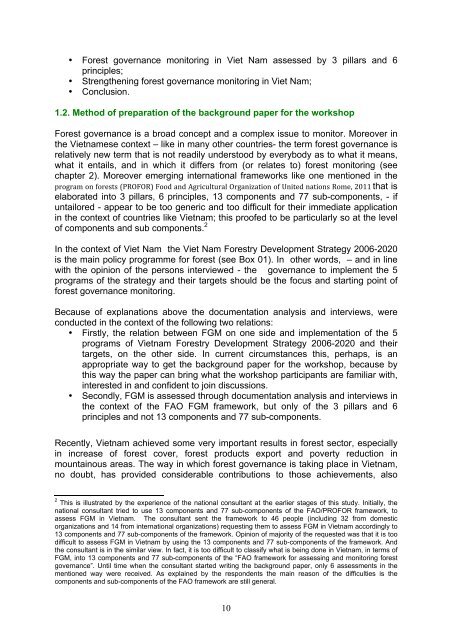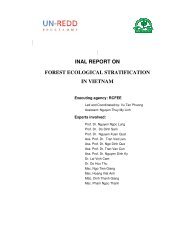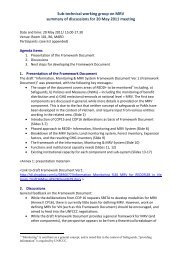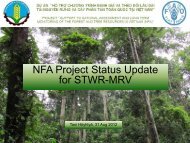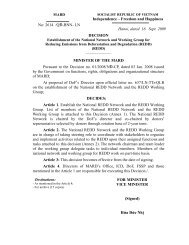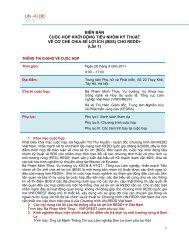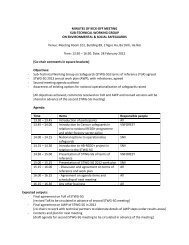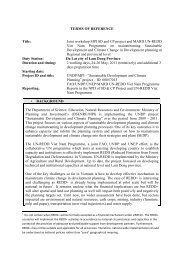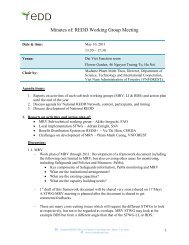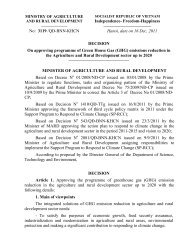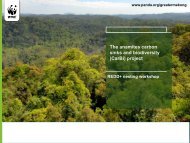FGM Workshop Background Paper - REDD - VietNam
FGM Workshop Background Paper - REDD - VietNam
FGM Workshop Background Paper - REDD - VietNam
You also want an ePaper? Increase the reach of your titles
YUMPU automatically turns print PDFs into web optimized ePapers that Google loves.
• Forest governance monitoring in Viet Nam assessed by 3 pillars and 6<br />
principles;<br />
• Strengthening forest governance monitoring in Viet Nam;<br />
• Conclusion.<br />
1.2. Method of preparation of the background paper for the workshop<br />
Forest governance is a broad concept and a complex issue to monitor. Moreover in<br />
the Vietnamese context – like in many other countries- the term forest governance is<br />
relatively new term that is not readily understood by everybody as to what it means,<br />
what it entails, and in which it differs from (or relates to) forest monitoring (see<br />
chapter 2). Moreover emerging international frameworks like one mentioned in the<br />
program on forests (PROFOR) Food and Agricultural Organization of United nations Rome, 2011 that is<br />
elaborated into 3 pillars, 6 principles, 13 components and 77 sub-components, - if<br />
untailored - appear to be too generic and too difficult for their immediate application<br />
in the context of countries like Vietnam; this proofed to be particularly so at the level<br />
of components and sub components. 2<br />
In the context of Viet Nam the Viet Nam Forestry Development Strategy 2006-2020<br />
is the main policy programme for forest (see Box 01). In other words, – and in line<br />
with the opinion of the persons interviewed - the governance to implement the 5<br />
programs of the strategy and their targets should be the focus and starting point of<br />
forest governance monitoring.<br />
Because of explanations above the documentation analysis and interviews, were<br />
conducted in the context of the following two relations:<br />
• Firstly, the relation between <strong>FGM</strong> on one side and implementation of the 5<br />
programs of Vietnam Forestry Development Strategy 2006-2020 and their<br />
targets, on the other side. In current circumstances this, perhaps, is an<br />
appropriate way to get the background paper for the workshop, because by<br />
this way the paper can bring what the workshop participants are familiar with,<br />
interested in and confident to join discussions.<br />
• Secondly, <strong>FGM</strong> is assessed through documentation analysis and interviews in<br />
the context of the FAO <strong>FGM</strong> framework, but only of the 3 pillars and 6<br />
principles and not 13 components and 77 sub-components.<br />
Recently, Vietnam achieved some very important results in forest sector, especially<br />
in increase of forest cover, forest products export and poverty reduction in<br />
mountainous areas. The way in which forest governance is taking place in Vietnam,<br />
no doubt, has provided considerable contributions to those achievements, also<br />
2 This is illustrated by the experience of the national consultant at the earlier stages of this study. Initially, the<br />
national consultant tried to use 13 components and 77 sub-components of the FAO/PROFOR framework, to<br />
assess <strong>FGM</strong> in Vietnam. The consultant sent the framework to 46 people (including 32 from domestic<br />
organizations and 14 from international organizations) requesting them to assess <strong>FGM</strong> in Vietnam accordingly to<br />
13 components and 77 sub-components of the framework. Opinion of majority of the requested was that it is too<br />
difficult to assess <strong>FGM</strong> in Vietnam by using the 13 components and 77 sub-components of the framework. And<br />
the consultant is in the similar view. In fact, it is too difficult to classify what is being done in Vietnam, in terms of<br />
<strong>FGM</strong>, into 13 components and 77 sub-components of the “FAO framework for assessing and monitoring forest<br />
governance”. Until time when the consultant started writing the background paper, only 6 assessments in the<br />
mentioned way were received. As explained by the respondents the main reason of the difficulties is the<br />
components and sub-components of the FAO framework are still general.<br />
10


